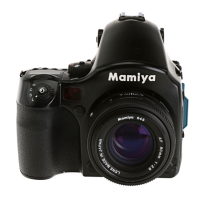
Do you have a question about the Mamiya 645 AFD II and is the answer not in the manual?
| Type | Medium Format SLR |
|---|---|
| Lens Mount | Mamiya 645 AF |
| Sensor Type | CCD |
| Sensor Size | 44 x 33 mm |
| Viewfinder | Pentaprism |
| Optical Viewfinder | Yes |
| Weight | 980 g (body only, without batteries) |
| Shutter Speed | 1/4000 to 30 sec |
| Storage | CF Card |
| Battery | Li-ion |
| Camera Format | 645 (6x4.5) |
Advice for professional users on maintenance and service schedules.
Details the various icons and data shown on the camera's main display screen.
Explains the information displayed on the film magazine's LCD panel.
Explains the functions assigned to the camera's front and rear dials.
Describes the various readouts and symbols on the camera's LCD screens.
Instructions on how to load and check the camera's batteries.
How to monitor the battery level and its implications.
Guide for powering the film magazine's LCD.
Recommendations for handling and maintaining camera batteries.
Procedure for mounting a lens onto the camera body.
Procedure for detaching a lens from the camera body.
Steps required before attaching the magazine to the camera.
Procedure for safely removing the film magazine.
Guide on how to change the viewfinder's diopter lens.
Procedure for mounting the lens.
Procedure for mounting the film magazine.
Instructions for safely removing exposed film from the magazine.
Procedure for handling film that has not been fully exposed.
How to achieve sharp focus using the camera's autofocus system.
Proper technique for operating the shutter button and holding the camera.
Mode for stationary subjects where focus is locked.
Mode for moving subjects, with continuous focus tracking.
How to select the specific area for autofocus.
Troubleshooting steps when autofocus is not functioning correctly.
Explanation of the AF assist beam's function and usage.
Advance film by one frame per shutter release.
Take rapid-fire shots by holding down the shutter button.
Releases the shutter after a set delay for self-portraits or group shots.
Information on cleaning and maintaining camera and accessory electrical contacts.
Camera automatically sets aperture and shutter speed for optimal exposure.
Allows adjustment of aperture/shutter speed in Program AE mode.
User sets shutter speed; camera selects aperture.
Sets shutter speed to flash sync speed (1/125 sec) for flash photography.
Allows customization of various camera settings.
Measures light across the entire frame with center emphasis.
Measures light from a small central area of the frame.
Automatically selects metering mode based on scene brightness.
Using the dedicated dial for exposure compensation.
Using the rear dial for exposure compensation adjustments.
Displays the difference between metered and set exposure values.
Takes one auto-bracketed shot per shutter press.
Takes multiple auto-bracketed shots with one shutter press.
Procedure to exit the multiple exposure function.
Advice on exposure adjustments for multiple exposures.
How to use mirror-up with AF and auto exposure modes.
How to use mirror-up with manual exposure settings.
Prevents light from entering the viewfinder to avoid exposure errors.
How to adjust the delay time for the self-timer.
Illuminates the LCD panels for use in low light conditions.
Explains depth of field and how to preview it.
Guide to using external flash units with the camera.
Details on using Metz flashes with the SCA3952 adapter.
Symbols and data shown in the viewfinder.
Using non-Metz flashes with the camera.
Superimposing shooting information and an index number.
Superimposing the date, time, and an index number.
Superimposing only the index number.
Select or store custom function profiles.
Set the increment for shutter speed and aperture adjustments.
Set the increment for exposure compensation adjustments.
Choose the active area for autofocus.
Specify which shooting data appears on the film.
Controls aperture behavior after lens changes.
Adjusts the auto-off timer for LCD displays.
Sets the maximum exposure compensation limit.
Configures backlight behavior.
Sets automatic mirror return time.
Sets the sequence for auto-bracketing exposures.
Defines how to cancel the auto-bracketing function.
Chooses how bracketing is applied in Manual mode.
Reassigns dial functions in Manual mode.
Assigns functions to secondary dials in Tv/Av modes.
Configures dial rotation direction.
Controls how program shift affects aperture/shutter speed.
Reassigns the AE Lock and AF Lock buttons.
Configures AE/AF lock activation via half-press.
Sets how AE lock is maintained or cancelled.
Controls the visibility of the AF focus mark.
Toggles display of exposure meter difference.
Configures one-push shift behavior.
Sets maximum duration for Bulb mode.
Configures Bulb mode shutter release behavior.
Sets shutter speed for flash synchronization.
Configures shutter speed for flash in P/Av modes.
Links camera and flash exposure compensation.
Enables or disables the AF assist beam.
Copies custom settings between user profiles.
Resets custom functions to default settings.
Allows shutter release without film.
Configures film winding initiation.
Sets number of shots for multiple exposure.
Controls user function selection with digital backs.
Sets the camera's internal clock.
Configures the index numbering system for film.
How to connect an external battery pack for extended power.
How to attach the camera to a tripod.
Port for connecting an electronic remote release.
A holder for film carton tops or other reminders.
Troubleshooting guide for common camera issues and display indicators.
Routine checks and upkeep for the camera.
Explains why regular maintenance is crucial for camera longevity.
Information on warranty, service centers, and repairs.
